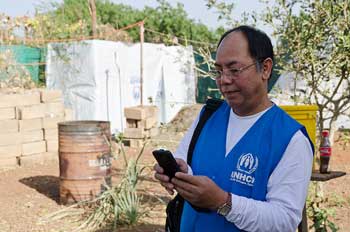
South Sudan pioneers ETC response solution

Hunger; insecurity; displacement; remoteness; natural disasters; disease – the challenges that face the people of South Sudan are immense. And, after almost half a century of civil war, even the most basic infrastructure to assist expanding humanitarian operations is virtually non-existent... until...
In January 2012 the ground-breaking new Emergency Telecommunications Cluster (ETC) response solution was pioneered in South Sudan, through successful technical deployments in Bentiu, Maban, Renk and Pibor. Now, as the humanitarian situation across the country worsens, relief workers in these four locations have access to reliable voice and data communications to expand and better manage their emergency operations.
"The people in Maban were really happy when we told them we were there to install internet," says Rob Buurveld, World Food Programme (WFP) Fast IT and Telecommunications Emergency and Support Team (FITTEST). "They just kept saying ‘Really?! When can we connect?' They were working with a BGAN for about 15 people."
The ETC was officially activated in South Sudan in September 2011 with World Food Programme (WFP) nominated as the lead agency. At this time, WFP had already been coordinating regular inter-agency working group meetings with ICT representatives from UN agencies and NGOs. The new solution is being developed for the ETC in collaboration with the Government of Luxembourg, WFP and Ericsson Response.
"At cluster meetings we were being asked if we could help with providing voice and data communications in remote areas of the country," says Arthur Sawmadal, WFP Head of IT in South Sudan. "WFP was already working with the Government of Luxembourg and Ericsson Response to develop a solution so we spoke with them about the possibility of deploying it in South Sudan."
The ETC solution comprises two key technologies - emergency.lu and WIDER. Initially a public-private partnership between the Government of Luxembourg and Luxembourg-based companies SES TechCom, HITEC Luxembourg and Luxembourg Air Ambulance, emergency.lu is a multi-layer platform to fill the communications gap at the onset of large-scale disasters. The solution consists of satellite infrastructure and capacity; communication and coordination services; satellite ground terminals for short and long-term deployment; communication terminals to extend satellite connection to the ground, and transportation of equipment to the disaster area.

"The rapid deployment solution is packed for a commercial flight," says Marianne Donven, Directorate for Development Cooperation of the Luxembourg Ministry of Foreign Affairs. "It consists of eight boxes that weigh less than 32 kilograms each. This includes an inflatable satellite antenna which is light weight and can fold up completely for transport.
"The long-term deployment kit has a standard 2.4 metre satellite dish. It is special in that it allows very quick set up and has no loose pieces. The kits also include IP (internet protocol) phones to allow voice communications."
As global lead of the ETC, and local lead in South Sudan, WFP is involved in setting the requirements and developing the solution on behalf of the humanitarian community, as well as coordinating the maiden installation in South Sudan. Installation of switches and access points to extend and distribute services for wired and wireless devices, and linking of central sites to remote locations are part of the ETC mandate. It is also anticipated that the ETC response solution will incorporate WFP's pioneering Emergency Preparedness Integration Centre (EPIC) in later implementations.
Provided by Ericsson Response, WIDER (Wireless Local Area Network in Disaster Emergency Response) is a central globalised management solution that provides secure network access and allows for monitoring use of internet services. Installed by staff volunteers through Ericsson Response, WIDER goes beyond standard WLAN services and provides aid workers in emergencies with more cost effective, reliable and secure connectivity.
"It's like a flyaway kit," says Martin Falebrand, Ericsson Response volunteer. "You can quite easily take WIDER with you wherever you go and have it up and running within a couple of hours."
The key advantage of WIDER is bandwidth management. "You manage all accesses and can easily identify when the Wi-Fi is most used which helps in knowing how to optimize the network," says Martin. "You can also set priorities so if there are a lot of users you can give ICT staff, for example, priority to get the bandwidth they need."
Through WIDER the exact number of users can be determined as well as which organizations they represent. To date, more than 550 humanitarian workers from over 50 organizations have connected in South Sudan including: ACTED, GOAL, International Red Cross, Intersos, Relief International, Samaritan's Purse, Save the Children, UNHCR, UNICEF, UNDP, WFP, World Bank and World Vision International.
The escalating humanitarian crisis, compounding with the lack of public infrastructure and remoteness of locations demanded a quick solution to provide the aid community with internet connectivity not only for operational efficiency, but also for their own safety. In October 2011 the seemingly over-ambitious deadline of January 2012 was set for the inaugural deployment of the solution. A joint team of technicians from WFP, Luxembourg Civil Protection and Ericsson Response succeeded in implementing the first system in Bentiu on January 7, 2012.
"It has really benefited humanitarian operations in this country," says Marianne. "I could feel that with all the efforts we have put into this project over the last two years, we have really come up with a valuable solution that will truly improve humanitarian response."
By Mariko Hall, Emergency Telecommunications Cluster